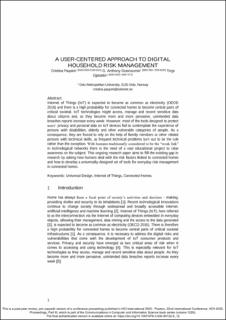A User-Centered Approach to Digital Household Risk Management
Journal article, Peer reviewed
Accepted version
Permanent lenke
https://hdl.handle.net/10642/9913Utgivelsesdato
2020-07-10Metadata
Vis full innførselSamlinger
Originalversjon
Paupini, Giannoumis, Gjøsæter. A User-Centered Approach to Digital Household Risk Management. Communications in Computer and Information Science. 2020;1226:82-88 https://doi.org/10.1007/978-3-030-50732-9_12Sammendrag
Internet of Things (IoT) is expected to become as common as electricity (OECD 2016) and there is a high probability for connected homes to become central parts of critical societal. IoT technologies might access, manage and record sensitive data about citizens and, as they become more and more pervasive, unintended data breaches reports increase every week. However, most of the tools designed to protect users’ privacy and personal data on IoT devices fail to contemplate the experience of persons with disabilities, elderly and other vulnerable categories of people. As a consequence, they are forced to rely on the help of family members or other related persons with technical skills, as frequent technical problems turn out to be the rule rather than the exception. With humans traditionally considered to be the “weak link” in technological networks there is the need of a vast educational project to raise awareness on the subject. This ongoing research paper aims to fill the existing gap in research by asking how humans deal with the risk factors linked to connected homes and how to develop a universally designed set of tools for everyday risk management in connected homes.
